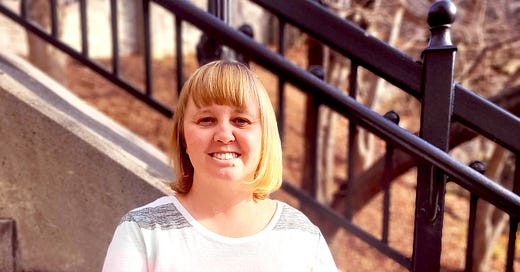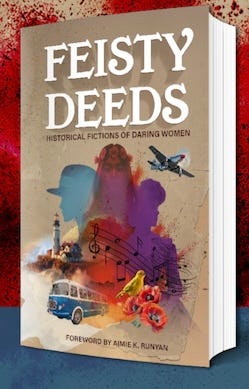Beth Anne Hill is Southern Historical Women's Fiction Writer. She writes stories about family, love, frailty, and resilience inspired by the places and people tucked along the back roads of Alabama. When she was a child, she wrote all the time. Her mother bought “Around the World" dolls for her, and she wrote a story for each one. She credits her 3rd through 6th-grade teacher, Mrs. Hall, for her love of writing. Beth Anne spent countless hours writing messy manuscripts about westward expansion and the Civil War in Charleston. She has a Bachelor of Science in Elementary Education and worked as a Montessori teacher where she shared her love for reading, writing, and our nation’s rich, multicultural past with her students. She is a member of the Alabama Historical Association, the Women’s Fiction Writers Association, and the American Historical Novels Facebook Group and Book Club. Beth Anne’s passion for America’s push into the West shows in her short story, “Tracing the Spirit.”
“Tracing the Spirit,” which was inspired by the Native American women who owned and operated stands along the Natchez Trace in the early 1800s, features a tenacious woman who challenges U.S. expansion to preserve her Chickasaw heritage. For me, Beth Anne’s feisty woman represented all the women who strived to save their land and ancestry during the big land grabs of our past and present. I was inspired by feisty woman’s ingenuity and courage, and I think you will be also when you read this story, “Tracing the Spirit.” Checkout Beth Anne’s website for more information, https://www.bethannewriter.com/ . When you read her story let me know how much you liked it and send a note with your thoughts.
Beth Anne’s Interview: “Tracing the Spirit”
1. How did this story come to you and how did you get the idea for your Feisty Female Character?
My mother and I drove the Natchez Trace, starting from the northern tip in Nashville, Tennessee, and as far south as Tupelo, Mississippi, in 2014. So much about the Trace stuck with me. Historical facts, like the fact that Abraham Lincoln's father was a “Kaintuck”, a boatman who floated wares down the Mississippi River and walked back up the Trace. Knowing that when I walked the sections of the Old Trace, I followed the footsteps of not just Lincoln's father but also those of Indigenous people (like my Cherokee ancestors) and enslaved people. I always wonder about those who came before me and stood in the exact spot where I was standing.
My Feisty Female Character, Anna Gowan, is inspired by the Chickasaw women who operated stands along the Old Trace. Jacobite Scots and frontiersmen, known as Indian Countrymen, often married Indigenous women from matrilineal tribes to gain access to land and trade. I wondered what their lives must have been like and how they felt, watching the culture they had married into acquire their homeland as they were forced to relinquish their own heritage.
2. What’s your writing process/routine?
For story inspiration, I always start with the setting. That's true for both of my work-in-progress novel manuscripts and completed short stories. Places speak to me and lead to curiosity about the people who lived there. I am a combination of a "pantser" and a "plotter." I utilize the three-act-story structure to provide a basic outline before I get started. Knowing the end of the story is important to staying focused and keeping the plot from running away with itself. But, I have to give myself freedom to create and see where the characters need to go. That's huge - taking myself out of the story and seeing it through the characters' eyes.
3. What was the hardest part of writing this story?
The hardest part of writing this story was tackling a short story. I wrote a short story to submit to a contest years ago, but the tale exceeded the restricted word count. I never successfully trimmed the word count, therefore shelving the story
4. How do you select your character’s names?
This is a great question! Admittedly, Anna's name just came to me. There is not a fascinating story behind her first name. However, I find most of my character's names on gravestones either in graveyards or cemeteries. I've been to or through ancestry/find-a-grave web searches. I mix and match name combinations to honor the anonymity of the deceased and for creativity.
5. Describe your writing space.
My writing space is in my bedroom. I have two cozy lamps with Edison bulbs to use at night and on rainy days, sweet grass baskets to hold my pens, a sunny bay window, and my favorite writing companion - my 14 year old fur baby, Dixie. She never judges, but she often snores.
6. Do you only write only Historical Fiction or do you write other genres?
So far, I've only written Historical Fiction. Someday, I'd love to try writing a dual timeline story. Well, I kind of am right now, but it's all still historical - set against the backdrop of the Battle of Horseshoe Bend and early Alabama statehood.
7. What question do you wish someone would ask you about yourself and/or your story and no one has?
How was I first inspired to become a writer? Easy. My 3rd-6th grade teacher, Mrs. Hall, opened the door to my love of reading, writing, and history. My first memory of her classroom is the author's chair. It was one of those canvas and wood director's chairs, but she called it the author's chair. Whenever we wrote something (a story, poem, report, anything), we got to sit in the writer's chair and read our work aloud to the class. Mrs. Hall passed away a few years ago; I wish she could read "Tracing the Spirit" and the anthology. She was my first editor, spending countless hours editing my "books." I still hear her advice in my head when I'm writing.
I’d love to hear your thoughts on Beth Anne’s interview and her story, especially if you’ve read Feisty Deeds: Historical Fictions of Daring Women on NetGalley. Please sign up for our giveaway open June 8-July 8, 2024. It’s available by adding your name to our mailing list at Contact - DW Hogan (She’s collecting the entries.)






